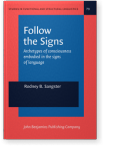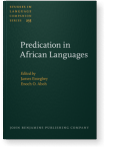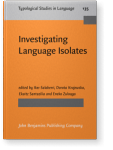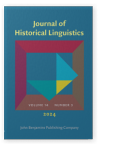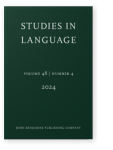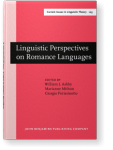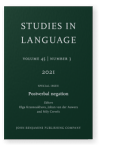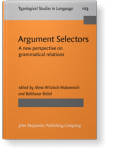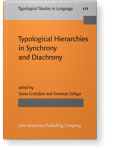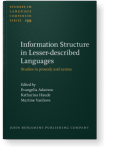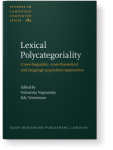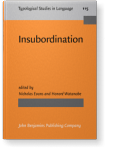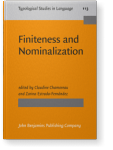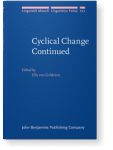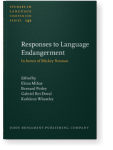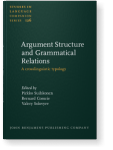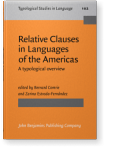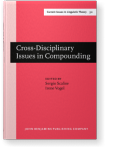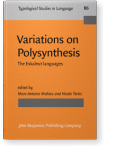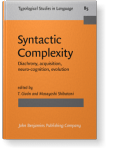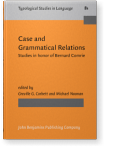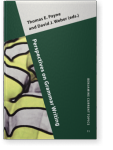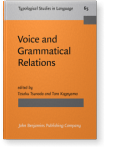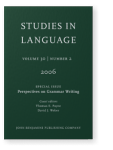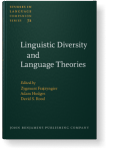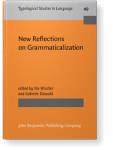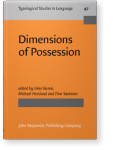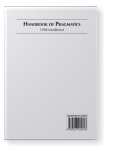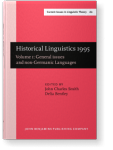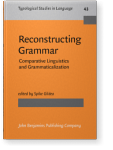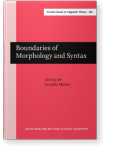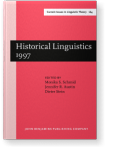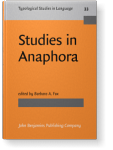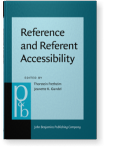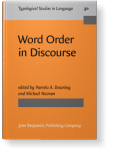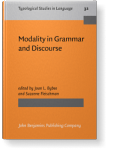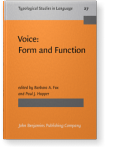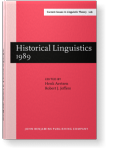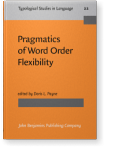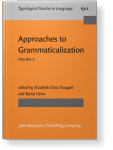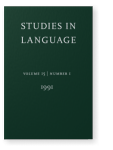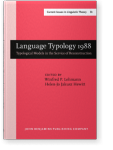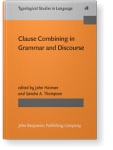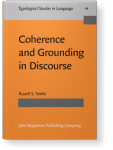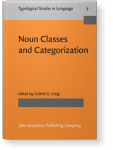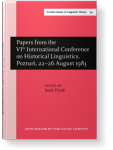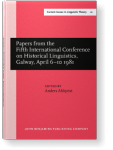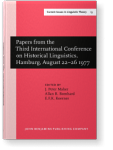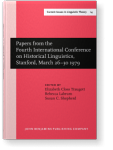Marianne Mithun
List of John Benjamins publications for which Marianne Mithun plays a role.
Book series
Journals
ISSN 2210-2116 | E-ISSN 2210-2124
ISSN 0378-4177 | E-ISSN 1569-9978
Title
Linguistic Perspectives on Romance Languages: Selected Papers from the XXI Linguistic Symposium on Romance Languages, Santa Barbara, February 21–24, 1991
Edited by William J. Ashby, Marianne Mithun and Giorgio Perissinotto
[Current Issues in Linguistic Theory, 103] 1993. xxii, 404 pp.
Subjects Romance linguistics
2021 Chapter 2. Antipassive propensities and alignment Antipassive: Typology, diachrony, and related constructions, Janic, Katarzyna and Alena Witzlack-Makarevich (eds.), pp. 43–64 | Chapter
Antipassive constructions were once thought to be unique to languages with ergative/absolutive alignment. Subsequent work demonstrated their existence in languages with nominative/accusative alignment as well. Here antipassives are described in languages with a third kind of system, agent/patient… read more
2021 Stories behind post-verbal negation clustering Postverbal negation, Krasnoukhova, Olga, Johan van der Auwera and Mily Crevels (eds.), pp. 684–706 | Article
Post-verbal markers of negation were once thought to be rare cross-linguistically, but as more has been learned about more languages, it has become clear that such markers occur in a number of parts of the world. Moreover, they often appear in areal clusters, suggesting that language contact may… read more
2020 Chapter 3. Prosody and the organization of information in Central Pomo, a California indigenous language In Search of Basic Units of Spoken Language: A corpus-driven approach, Izre'el, Shlomo, Heliana Mello, Alessandro Panunzi and Tommaso Raso (eds.), pp. 107–126 | Chapter
In some theoretical frameworks, it is assumed that prosodic structure is a direct reflection of syntactic structure. Close examination of unscripted speech confirms that though the two often work in concert, they are distinct. Prosodic structure differs from grammatical structure in some… read more
2020 Chapter 1. Discourse particle position and information structure Information-Structural Perspectives on Discourse Particles, Modicom, Pierre-Yves and Olivier Duplâtre (eds.), pp. 27–46 | Chapter
Discourse markers differ cross-linguistically not only in their functions but also in their positions within the sentence. Some are sentence-initial, some are sentence-final, and some occur in what has been termed the ‘middle-field’. But many appear simply in second position in the sentence. In… read more
2020 Chapter 4. Basic units of speech segmentation In Search of Basic Units of Spoken Language: A corpus-driven approach, Izre'el, Shlomo, Heliana Mello, Alessandro Panunzi and Tommaso Raso (eds.), pp. 349–358 | Chapter
The segmentation of the monologue Navy and the dialogue Hearts described here is based solely on the acoustic signal. The unit of reference is the intonation unit as defined in the work of Chafe, characterized by a single, coherent pitch contour. Units defined by pitch often coincide with… read more
2019 Grammatical relations in Hiligaynon Argument Selectors: A new perspective on grammatical relations, Witzlack-Makarevich, Alena and Balthasar Bickel (eds.), pp. 131–184 | Chapter
In typological work on grammatical relations, languages of the Philippines have long presented challenges. The challenges are due in part to differences across the languages, and in part to the nature of the data underlying analyses. Here the system is described for one Philippine language,… read more
2018 Chapter 3. Deconstructing teleology: The place of synchronic usage patterns among processes of diachronic development Typological Hierarchies in Synchrony and Diachrony, Cristofaro, Sonia and Fernando Zúñiga (eds.), pp. 111–128 | Chapter
A central issue in typology is the role of implicational hierarchies in shaping individual languages. One view is that the hierarchies guide language change, or at least constrain it: “Since a hierarchy constrains what is a possible language, it is also a constraint on language change, because… read more
2018 Chapter 5. Factors behind variation in marking information structure: Contributions from Central Pomo Information Structure in Lesser-described Languages: Studies in prosody and syntax, Adamou, Evangelia, Katharina Haude and Martine Vanhove (eds.), pp. 119–156 | Chapter
Prosody and morphosyntax are exploited in most languages for expressing information structure, but the contributions of each vary. Some of the factors underlying the both cross-linguistic similarities and the variation are differences between the two, in particular (i) their patterns of development… read more
2017 Polycategoriality and zero derivation: Insights from Central Alaskan Yup’ik Eskimo Lexical Polycategoriality: Cross-linguistic, cross-theoretical and language acquisition approaches, Vapnarsky, Valentina and Edy Veneziano (eds.), pp. 155–174 | Chapter
The possibility of polycategorial lexical items, unspecified for category, raises interesting issues. One is the predictability of semantic relationships between polycategorial forms in predicating and referring uses. Another is the language-internal generality of the phenomenon, whether it… read more
2016 Chapter 14. How fascinating! Insubordinate exclamations Insubordination, Evans, Nicholas and Honoré Watanabe (eds.), pp. 367–392 | Article
It has been noticed that in language after language, exclamatives resemble some other sentence type, usually interrogatives: How cute she is! How cute is she? Explanations for the similarities have generally been couched in terms of shared abstract syntactic or semantic structure. Here another kind… read more
2016 Shifting finiteness in nominalization: From definitization to refinitization Finiteness and Nominalization, Chamoreau, Claudine and Zarina Estrada-Fernández (eds.), pp. 297–322 | Article
A significant effect of clause nominalization is the loss of finiteness, of such morphological features as tense, aspect, mood, and valency, and the acquisition of such nominal features as case, gender, number, possession, and determiners. The constructions cease to function syntactically as… read more
2016 What cycles when and why Cyclical Change Continued, Gelderen, Elly van (ed.), pp. 19–46 | Article
Certain kinds of grammatical markers show heightened propensities for turnover cross-linguistically. Some, like negatives, are widespread, while others, such as distributives, are rarer. Several factors might underlie these propensities. Most cycles involve two sets of processes: grammaticalization… read more
2014 Prosody and information structure: Segmentation, integration, and in between Spoken Corpora and Linguistic Studies, Raso, Tommaso and Heliana Mello (eds.), pp. 297–330 | Article
In this paper the focus is on syntactic and prosodic structures in a language that is typologically quite different from the majority languages of Europe and Asia. Mohawk, a language of the Iroquoian family, is indigenous to northeastern North America. Examples cited here are drawn from unscripted… read more
2013 What can revitalization work teach us about documentation? Responses to Language Endangerment: In honor of Mickey Noonan, Mihas, Elena, Bernard Perley, Gabriel Rei-Doval and Kathleen Wheatley (eds.), pp. 21–42 | Article
As language documentation gains recognition as an important methodology for linguistics, and as communities mount ever more impressive revitalization projects, the interests of academic and community scholars are converging. It is useful to look to those involved in revitalization for their views… read more
2012 Core argument patterns and deep genetic relations: Hierarchical systems in Northern California Argument Structure and Grammatical Relations: A crosslinguistic typology, Suihkonen, Pirkko, Bernard Comrie and Valery Solovyev (eds.), pp. 257–294 | Article
It has been proposed that patterns of core argument marking have high genetic stability and strong resistance to areal influence, making them good indicators of deep genetic relationships (Nichols 1992). Patterns in four languages of Northern California indicate that this is not necessarily the… read more
2012 Questionable relatives Relative Clauses in Languages of the Americas: A typological overview, Comrie, Bernard and Zarina Estrada-Fernández (eds.), pp. 269–300 | Article
In a number of languages, interrogative and relative pronouns show the same forms. The pattern is not distributed evenly around the globe, however: it is concentrated in Europe. It does appear elsewhere, for example in South America in Tariana (in contact with Portuguese), and in Mesoamerica in… read more
2010 Constraints on compounds and incorporation Cross-Disciplinary Issues in Compounding, Scalise, Sergio and Irene Vogel (eds.), pp. 37–56 | Article
This chapter examines the status of a type of compounding often cited as a construction that straddles the boundary between morphology and syntax. Noun incorporation constructions in Kapampangan, Mohawk, and Central Alaskan Yup’ik Eskimo are evaluated with respect to the No Phrase Constraint and… read more
2009 Polysynthesis in the Arctic Variations on Polysynthesis: The Eskaleut languages, Mahieu, Marc-Antoine and Nicole Tersis (eds.), pp. 3–17 | Chapter
Among the most frequently cited typological characteristics of American languages is polysynthesis, a term coined in 1816 by Duponceau to describe words in American languages containing large numbers of morphemes. Major scholars since that time, including Boas, Sapir, and Greenberg, have also… read more
2009 Re(e)volving complexity: Adding intonation Syntactic Complexity: Diachrony, acquisition, neuro-cognition, evolution, Givón, T. and Masayoshi Shibatani (eds.), pp. 53–80 | Article
A fruitful methodology for tracing the development of grammatical complexity has been the examination of centuries of written texts. Yet written documents necessarily remain silent about the prosody of the evolving constructions. An awareness of prosodic patterns can further our understanding of… read more
2008 Does passivization require a subject category? Case and Grammatical Relations: Studies in honor of Bernard Comrie, Corbett, Greville G. and Michael Noonan (eds.), pp. 211–240 | Article
Passives are usually described in terms of subjects: they shift subject status from the semantic agent of a clause to a patient or other argument. We might accordingly expect that languages without a robust subject category should lack passives. Here passives are examined in a language with at best… read more
2007 Grammars and the community Perspectives on Grammar Writing, Payne, Thomas E. and David J. Weber (eds.), pp. 45–69 | Article
The audience for a grammatical description is an important consideration for anyone involved in descriptive linguistics. Potential grammar users include linguists, the interested public, and members of the communities in which the language is spoken. An awareness of the target audiences is… read more
2006 Voice without subjects, objects, or obliques: Manipulating argument structure in Agent/Patient systems (Mohawk) Voice and Grammatical Relations: In Honor of Masayoshi Shibatani, Tsunoda, Tasaku and Taro Kageyama (eds.), pp. 195–216 | Article
2006 Grammars and the community Perspectives on Grammar Writing, Payne, Thomas E. and David J. Weber (eds.), pp. 281–306 | Article
The audience for a grammatical description is an important consideration for anyone involved in descriptive linguistics. Potential grammar users include linguists, the interested public, and members of the communities in which the language is spoken. An awareness of the target audiences is… read more
2005 On the assumption of the sentence as the basic unit of syntactic structure Linguistic Diversity and Language Theories, Frajzyngier, Zygmunt, Adam Hodges and David S. Rood (eds.), pp. 169–183 | Article
2002 An invisible hand at the root of causation: The role of lexicalization in the grammaticalization of causatives New Reflections on Grammaticalization, Wischer, Ilse and Gabriele Diewald (eds.), pp. 237–257 | Article
2001 Lexical forces shaping the evolution of grammar Historical Linguistics 1999: Selected papers from the 14th International Conference on Historical Linguistics, Vancouver, 9–13 August 1999, Brinton, Laurel J. (ed.), pp. 241–252 | Article
2001 15. The difference a category makes in the expression of possession and inalienability Dimensions of Possession, Baron, Irène, Michael Herslund and Finn Sørensen (eds.), pp. 285–310 | Chapter
2001 Actualization patterns in grammaticalization: From clause to locative morphology in Northern Iroquoian Actualization: Linguistic Change in Progress, Andersen, Henning (ed.), pp. 143–168 | Article
2000 Word Handbook of Pragmatics: 1998 Installment, Verschueren, Jef, Jan-Ola Östman, Jan Blommaert † and Chris Bulcaen (eds.), pp. 1–17 | Article
2000 The Legacy of Recycled Aspect Historical Linguistics 1995: Volume 1: General issues and non-Germanic Languages., Smith, John Charles and Delia Bentley (eds.), pp. 261–278 | Article
2000 The reordering of morphemes Reconstructing Grammar: Comparative Linguistics and Grammaticalization, Gildea, Spike (ed.), pp. 231–256 | Article
1999 The Effect of Noun Incorporation on Argument Structure Boundaries of Morphology and Syntax, Mereu, Lunella (ed.), pp. 49–72 | Article
1999 What are S, A, and O? Studies in Language 23:3, pp. 569–596 | Article
The letters S, A, and O have been used heuristically for distinguishing ergative-absolutive languages from nominative-accusative languages. This schema, however, has serious disadvantages for the understanding of individual grammars and even more for broad typological work, because it obscures the… read more
1998 The Sequencing of Grammaticization Effects: A Twist from North America Historical Linguistics 1997: Selected papers from the 13th International Conference on Historical Linguistics, Düsseldorf, 10–17 August 1997, Schmid, Monika S., Jennifer R. Austin and Dieter Stein (eds.), pp. 291–314 | Article
1997 Lexical Affixes and Morphological Typology Essays on Language Function and Language Type: Dedicated to T. Givón, Bybee, Joan L., John Haiman and Sandra A. Thompson (eds.), pp. 357–372 | Article
1996 New Directions in Referentiality Studies in Anaphora, Fox, Barbara A. (ed.), pp. 413–436 | Article
1996 Prosodic Cues to Accessibility Reference and Referent Accessibility, Fretheim, Thorstein and Jeanette K. Gundel (eds.), pp. 223–234 | Article
1995 Morphological and prosodic forces shaping word order Word Order in Discourse, Downing, Pamela A. and Michael Noonan (eds.), pp. 387–423 | Article
1995 On the Relativity of Irreality Modality in Grammar and Discourse, Bybee, Joan L. and Suzanne Fleischman (eds.), pp. 367–388 | Article
1994 The Implications of Ergativity for a Philippine Voice System Voice: Form and Function, Fox, Barbara A. and Paul J. Hopper (eds.), pp. 247–278 | Article
1993 Reconstructing the Unidentified Historical Linguistics 1989: Papers from the 9th International Conference on Historical Linguistics, New Brunswick, 14–18 August 1989, Aertsen, Henk and Robert J. Jeffers (eds.), pp. 329–348 | Article
1992 Is basic word order universal? Pragmatics of Word Order Flexibility, Payne, Doris L. (ed.), pp. 15–62 | Article
1991 The role of motivation in the emergence of grammatical categories: the grammaticization of subjects Approaches to Grammaticalization: Volume II. Types of grammatical markers, Traugott, Elizabeth Closs and Bernd Heine (eds.), pp. 159–184 | Article
1991 Ives Goddard and Kathleen Bragdon. Native Writings in Massachusetts Studies in Language 15:1, pp. 259–261 | Miscellaneous
1991 The Development of Bound Pronominal Paradigms Language Typology 1988: Typological Models in the Service of Reconstruction, Lehmann, Winfred P. and Helen-Jo Jakusz Hewitt (eds.), pp. 85–104 | Article
1988 The grammaticalization of coordination Clause Combining in Grammar and Discourse, Haiman, John and Sandra A. Thompson (eds.), pp. 331–360 | Article
1987 Is basic word order universal? Coherence and Grounding in Discourse: Outcome of a Symposium, Eugene, Oregon, June 1984, Tomlin, Russell S., pp. 281–328 | Article
1986 The Convergence of Noun Classification Systems Noun Classes and Categorization: Proceedings of a symposium on categorization and noun classification, Eugene, Oregon, October 1983, Craig, Colette G. (ed.), pp. 379–398 | Article
1982 The mistery of the vanished Laurentinians Papers from the Fifth International Conference on Historical Linguistics, Galway, April 6–10 1981, Ahlqvist, Anders (ed.), pp. 230–242 | Article
1982 On comparative syntax Papers from the Third International Conference on Historical Linguistics, Hamburg, August 22–26 1977, Maher, J. Peter, Allan R. Bomhard and E.F.K. Koerner † (eds.), pp. 273–292 | Article
1980 A functional approach to syntactic reconstruction Papers from the Fourth International Conference on Historical Linguistics, Stanford, March 26–30 1979, Traugott, Elizabeth Closs, Rebecca Labrum and Susan C. Shepherd (eds.), pp. 87–96 | Article
